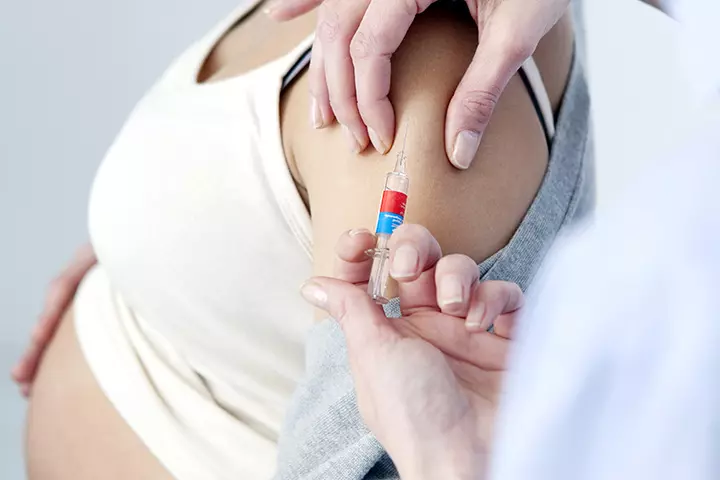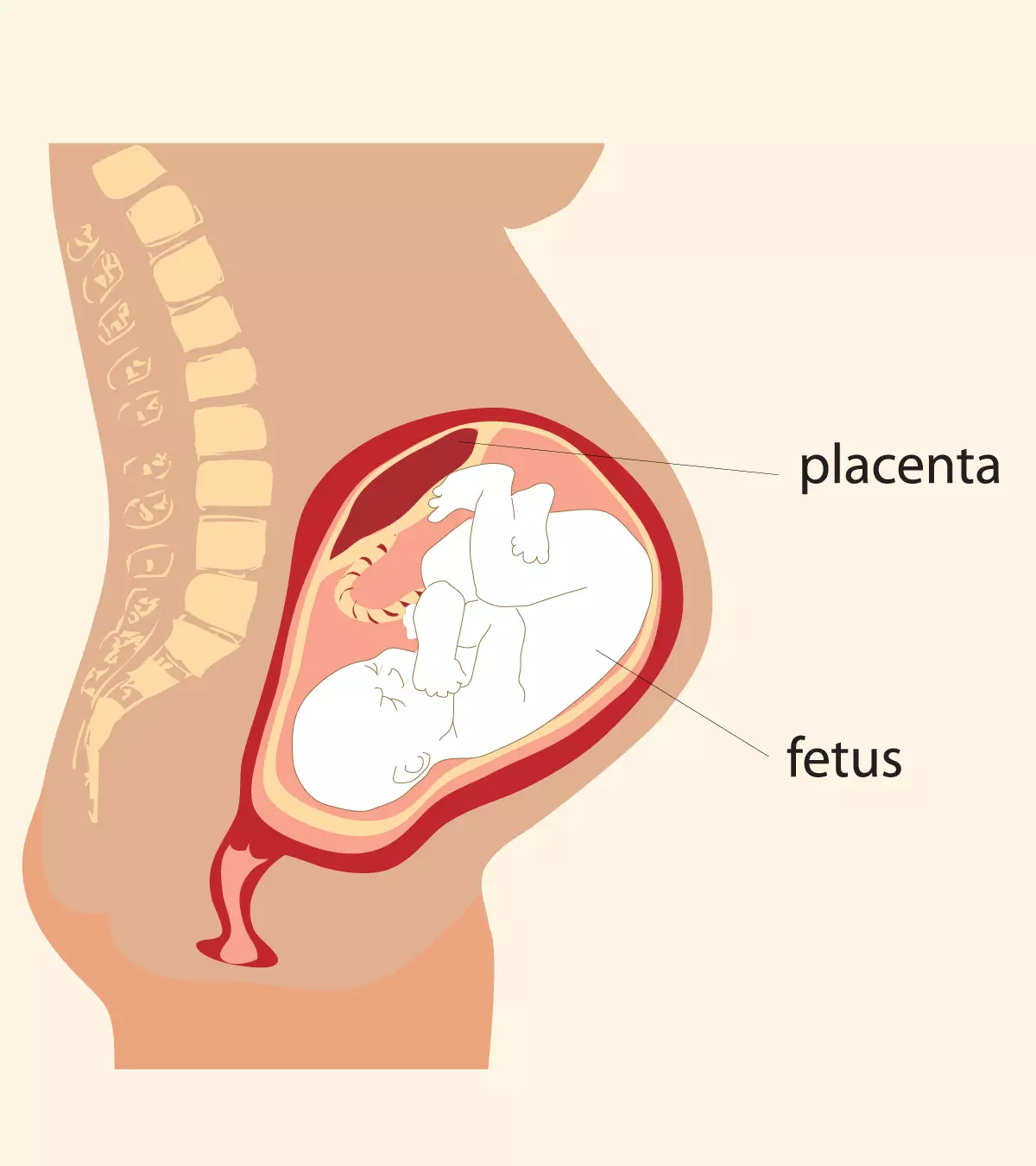
Image: Midjourney/ MomJunction Design Team
Abortion is a difficult and painful decision to take, irrespective of the reasons. And as your body has already started to prepare itself for the baby, abortion might give rise to a few complications, and lactating after abortion is one of them.

Such unwanted lactation might put you at risk of contracting infections, such as mastitisiBreast inflammation that may cause infection. . Thus, it is important to consult with your doctor and seek proper care and treatment. Read on to know more about lactation after abortion and tips to take care of yourself.
Key Pointers
- Lactation after abortion is a normal and natural occurrence for some women.
- Women can use prescription medications to suppress lactation if they choose to do so.
- Some natural ways to reduce lactation include expressing breast milk, using cold cabbage leaves, taking warm baths, using ice packs, and drinking sage tea.
- Resting, relaxing, and taking pain relief medications can help women cope with physical discomfort after an abortion.
- Women should seek medical help if they experience heavy vaginal bleeding, high fever, or severe abdominal pain.
Is It Normal To Express Milk After An Abortion?

Yes, it is normal for you to experience milk supply and production even after an abortion, as your body has already begun preparation for breastfeeding.
Following an abortion, the body experiences hormonal changes, which can affect lactation. A sudden decline in pregnancy hormones (estrogen and progesterone) may initiate milk production, akin to the process observed after childbirth. The pituitary gland might also release prolactin (the hormone crucial for milk synthesis) for a brief period (1). Although these hormonal fluctuations can lead to temporary milk production, the extent varies among individuals. Typically, you will notice milk production within three days of pregnancy termination, and the condition is natural.
While some may not feel too uncomfortable, others may experience pain and discomfort.
Regina Kincaid, breastfeeding and lactation expert, opines, “After a pregnancy termination, mothers may still produce milk, especially if the pregnancy was far along. They deserve care that acknowledges both their physical and emotional needs. There are options for managing lactation. Individual support in this situation can help to prevent unwanted breast discomfort and breast inflammation.”
 Quick fact
Quick factHow To Stop Lactation After Abortion?
Now that you know milk production/lactation is common after an abortion, you can choose to allow the milk production to subside on its own, or try to suppress it.
California-based lactation consultant and postpartum doula Laura Howells opines, “For most women, stopping milk production as quickly as possible after an abortion is a priority. The use of over-the-counter pseudoephedrine or estrogen-containing birth control is very effective, while some may require more targeted medication, such as bromocriptine.”
Your gynecologist is the right person to prescribe medications after personalized analysis. You may also try some simple steps to control the process of lactation after abortion.
- Expressing milk using a breast pump or your hand is important if your breasts feel full. However, use hand expression or gentle pumping to relieve discomfort and soften the breast, but not to drain it. If you ignore and don’t pump out the excess milk, you may develop mastitis, which can harden the breast tissue and lead to other infections. If you have painful redness on the breast and the condition doesn’t improve in 12 to 24 hours, or if you start feeling very sick, it’s essential to see your doctor, as antibiotics might be needed (3).
- Milk expression may help rid you of any discomfort you may experience due to lactating after abortion. A Stanford University study involving 47 participants who experienced a second-trimester abortion or loss found that nearly all individuals reported symptoms of breast engorgement and tenderness, with most finding these symptoms bothersome (4).
- You can also choose to donate your breast milk to a breast milk bank. Donor milk can be beneficial for sick or premature babies who are unable to receive their mother’s milk (5).
 Point to consider
Point to considerSteps To Take For Controlling Milk Production
When it comes to relieving discomfort associated with lactation after abortion, you could try these simple tips.
- Place raw, cold and washed cabbage leaves inside your bra- it may help to reduce milk production and milk letdown and ease any tenderness in the breasts(2).
- Take a warm water bath and ensure that the water runs over your breasts. This method can provide relief from pain and tenderness naturally(2).
- For intense pain, you could choose to place ice packs on your chest – it will also help reduce swelling. Just make sure you don’t use the ice packs for more than 10 minutes at a time (7).

- Drinking sage tea may also help dry up breastmilk production post-abortion (7).
- Make sure your bra isn’t too tight- avoid wearing a bra for at least a few hours every day- preferably while you sleep. But wear a suitable fitting bra, it will help with the pain (2).
Following these steps can help you naturally reduce post abortion lactation and calm down its associated symptoms as well.
Simple Care Tips Post-Abortion
Dealing with an abortion can be physically and mentally stressful. Thus, taking some simple steps can help you deal with it better.
- Take optimum rest and relax during the initial recovery period. Allow your body to recover and heal naturally (8).
- If you’re experiencing cramps and pain around the abdominal region, you could talk to your doctor about using pain relief medications such as Ibuprofen or Paracetamol, or use a warm water bottle on the abdomen.
- Avoid having sex for at least two days after the bleeding stops (8).
- Gently massaging the lower abdominal region can also help minimize pain and get the womb back to the normal size, and possibly even minimize bleeding.
- Take plenty of fluids.
- Do not insert anything, including tampons, into your vagina (8).
- Refrain from douching, taking baths, or swimming for two weeks. Showering is allowed, but avoid soaking in a tub (8).
- Seek medical help if you experience heavy vaginal bleeding, high fever, and severe abdominal pain (9).
- Finally, don’t hesitate to seek emotional support from family, friends, or support groups to help you through this time.
 Be watchful
Be watchful
Frequently Asked Questions
1. How long does it take for breastmilk to dry up after an abortion?
It may take a few days to weeks for your milk ducts to dry up after an abortion (3). However, the specific time for each case will vary depending on several factors, such as the method of abortion, how early in pregnancy the abortion happened, the level of oxytocin and prolactin hormones, and overall health.
2. Will there be changes in my breasts after a miscarriage?
Depending on how far along you were in the pregnancy, you may experience changes in your breasts after a miscarriage. For instance, in case of a late miscarriage, the mammary glands start to produce milk and cause breast engorgement/milk leakage (2). Also, they may feel tender and cause pain, especially when touched. However, these changes, in most cases, are transient and self-resolve within a few days or weeks.
3. How can I deal with the emotional fallout of lactating after an abortion?
Dealing with lactation after an abortion can be emotionally challenging. Seek support from trusted individuals, consider professional help, engage in self-care, express your emotions, educate yourself, and give yourself time to heal. California-based childbirth and breastfeeding educator Mindy Cockeram opines, “Emotions resulting from the loss of a baby and the milk you were creating for the baby should never be ignored. Milk production will cease quickly but emotional healing will take time and patience.” Remember, everyone’s journey is unique, so be patient and seek help if needed.
Dealing with lactation after an abortion can be emotionally challenging. Seek support from trusted individuals, consider professional help, engage in self-care, express your emotions, educate yourself, and give yourself time to heal. California-based childbirth and breastfeeding educator Mindy Cockeram opines, “Emotions resulting from the loss of a baby and the milk you were creating for the baby should never be ignored. Milk production will cease quickly but emotional healing will take time and patience.” Remember, everyone’s journey is unique, so be patient and seek help if needed.
Lactating after abortion can occur in some women due to hormonal changes. It can cause only emotional distress in some women, while a few may have breast pain and discomfort. You may choose to express milk and let the milk production cease naturally or prefer medications recommended by gynecologists to stop lactation after pregnancy loss. The amount of milk production and other symptoms may vary depending on the age of the pregnancy and other factors. However, it is important to express breastmilk to avoid breast engorgement and mastitis.
Infographic: Simple Care Tips Post-Abortion
After having an abortion, it is crucial to prioritize your physical and emotional well-being to ensure a smooth recovery. To help you through this process, we bring you an infographic with self-care tips. So, review these tips and consider sharing them with other women who may find them helpful.
Some thing wrong with infographic shortcode. please verify shortcode syntax
References
- Lactation.
https://my.clevelandclinic.org/health/body/22201-lactation - Women’s Physical Health After a Miscarriage.
https://rednose.org.au/article/womens-physical-health-after-a-miscarriage - Stopping breastfeeding after the loss of your baby or child.
https://www.healthywa.wa.gov.au/Articles/S_T/Stopping-breastfeeding-after-the-loss-of-your-baby-or-child - Henkel, A., et al.; (2025); The Experience of Breast Symptoms After Second-Trimester Abortion or Loss.
https://www.sciencedirect.com/science/article/abs/pii/S0010782423000793 - Donor breast milk and milk banks.
https://www.pregnancybirthbaby.org.au/donor-breast-milk-and-milk-banks - A Nyboe Andersen; (1990); Prevention of breast pain and milk secretion with bromocriptine after second-trimester abortion.
https://pubmed.ncbi.nlm.nih.gov/2220345/ - Lactation After Loss.
https://lllusa.org/lactation-after-loss/ - FAQ: Abortion Care and Recovery.
https://www.uclahealth.org/medical-services/obgyn/family-planning/patient-resources/faq-abortion-care-and-recovery - What to Expect after an Abortion.
https://en.hesperian.org/hhg/Where_Women_Have_No_Doctor:What_to_Expect_after_an_Abortion - Caring for yourself after your abortion.
https://www.bpas.org/abortion-care/aftercare-support/
Community Experiences
Join the conversation and become a part of our nurturing community! Share your stories, experiences, and insights to connect with fellow parents.
Read full bio of Dr. Richa Hatila Singh

Regina Kincaid qualified as a midwife in 2005 in Germany and has since worked in maternity care in England and Ireland. She achieved stage 1 of the UNICEF Baby Friendly accreditation as infant feeding lead midwife at Ealing Hospital in London. She did her Neonatal Examination Course from London City University and took the IBCLC exam in Dublin.
Regina Kincaid qualified as a midwife in 2005 in Germany and has since worked in maternity care in England and Ireland. She achieved stage 1 of the UNICEF Baby Friendly accreditation as infant feeding lead midwife at Ealing Hospital in London. She did her Neonatal Examination Course from London City University and took the IBCLC exam in Dublin.
- Mindy Cockeram is a board-certified lactation consultant and runs her private practice in South Carolina. She trained as an antenatal teacher with the National Childbirth Trust (NCT) in London, England and taught childbirth classes for the NCT and St Georges Hospital Trust. Later, she relocated to the US.
 Mindy Cockeram is a board-certified lactation consultant and runs her private practice in South Carolina. She trained as an antenatal teacher with the National Childbirth Trust (NCT) in London, England and taught childbirth classes for the NCT and St Georges Hospital Trust. Later, she relocated to the US.
Mindy Cockeram is a board-certified lactation consultant and runs her private practice in South Carolina. She trained as an antenatal teacher with the National Childbirth Trust (NCT) in London, England and taught childbirth classes for the NCT and St Georges Hospital Trust. Later, she relocated to the US. - Laura Howells is an IBCLC with over four years of experience. She has been working with families bringing new babies into their lives for 20 years now. Laura offers online classes, virtual one-on-one sessions as well as in-person appointments in her office in Albany, California.
 Laura Howells is an IBCLC with over four years of experience. She has been working with families bringing new babies into their lives for 20 years now. Laura offers online classes, virtual one-on-one sessions as well as in-person appointments in her office in Albany, California.
Laura Howells is an IBCLC with over four years of experience. She has been working with families bringing new babies into their lives for 20 years now. Laura offers online classes, virtual one-on-one sessions as well as in-person appointments in her office in Albany, California.
Read full bio of Ria Saha
Read full bio of Rebecca Malachi
Read full bio of Dr. Joyani Das



















